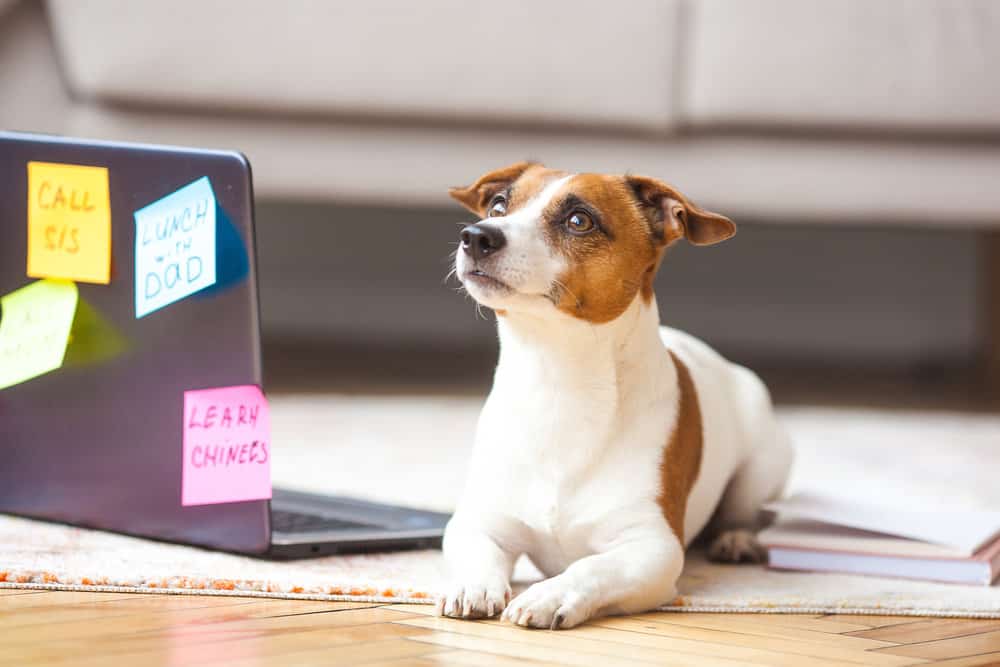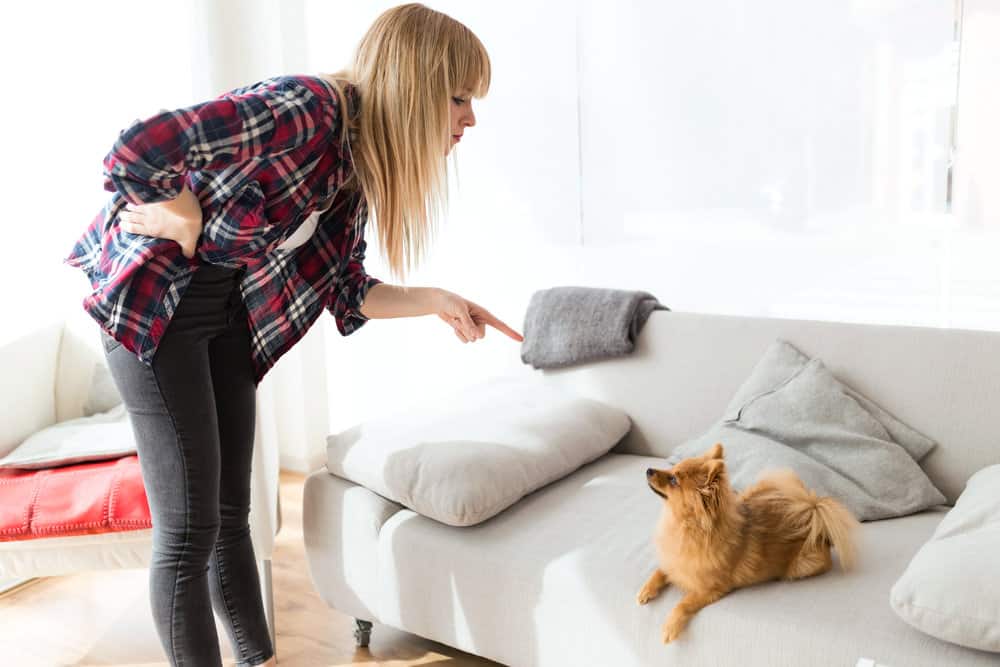When you leave the room, your puppy may be crying out of loneliness, boredom, or fear. While there may be other reasons, those are some of the most important ones to keep in mind.
When you have a puppy, you’ll discover how much he likes to play and interact with you. That's because dogs are highly social creatures that love attention. Other times, your puppy may just need a toy to play with or chew on while he's alone in order to stay happy and entertained.
Thankfully, you won’t be dealing with this issue for much longer. Bring your doggie closer and get ready to toughen them up!
What Causes My Puppy To Cry When I Leave Him?
Unfortunately for us, dogs don't have a common, understandable language like we do. That's why interpreting why your dog is crying can be rather rough.
A whimper or a whine could mean a million things, but today we're going to focus on three main reasons. Let’s start by looking at each one separately!

1. Loneliness
Dogs are naturally social creatures. As descendants of wolves, dogs are pack animals that rarely stray.
The first weeks of a puppy’s life are spent close to his mother and siblings. Basically, they’re his original pack that he sticks around.
Even though we’ve domesticated them over time and turned them into sweet pets, these instincts haven't completely faded.
So, moving into a new home with a human family, this pack dynamic changes a little. Now, this new family is his pack, and the owner is the leader.
By default, pack members don’t stray from each other. So, your companionship is a constant requirement.
When your pup cries every time you leave, he's likely trying to express his discomfort at being separated from you.
Plus, this issue could develop into separation anxiety, so it’s best to take a look at the various symptoms as well as how to prevent them.
2. Boredom
Another reason behind this crying or whining could be that your puppy is under-stimulated and needs attention from you. Sometimes he’ll start to whine because he has nothing to play with while you’re away.
Additionally, did you used to do some exercise or go out for walks with your dog, but got out of the habit? This may be why he's whining! He’s feeling frustrated and he wants to get back in shape
You could let out your little fur ball's pent-up energy by doing lots of activities together.
Other signs your dog is bored could be:
- Excessive barking
- Making a big mess
- Digging
- Hyper greetings
Helpful Dog Training Resource:
For help with training your dog, you should take a look at The Online Dog Trainer by Doggy Dan. Doggy Dan is an expert Dog Trainer based in New Zealand. His online resource contains Hundreds of Excellent Dog Training Videos that will take you step-by-step through the process of developing a healthy, happy well-behaved dog.
3. Fear
Sadly, his crying can also be attributed to fear. So, it’s time to bring out the Sherlock Holmes hat and figure out what could’ve caused your puppy’s reaction.
Start by looking at the toys your dog plays with. Did one of them make a noise or move in a way that startled him before?
This isn’t unusual, there’s actually a video of a dog that’s scared of a tiger toy!
Additionally, this could be because of extra family additions or visits. Introducing your pup to new pets or guests could leave him feeling anxious.
On top of that, what scares your puppy doesn’t stay the same forever. Dogs go through what’s known as “fear periods”, which are important for their survival.
These genetically determined patterns still exist even though dogs live as pets now. It generally happens between the ages of eight and 11 weeks old and five to 14 months old.
What Can You Do to Help Your Puppy?
Your puppy’s bad mood could fester and turn into a bigger problem that needs to be addressed.
Thankfully, you could easily solve it and help your dog!
Here’s how you could do it:
Exercise

To avoid boredom and under-stimulation, you can help your dog by providing him with a proper amount of daily exercise. Play games with him, walk him, or go on a training session.
Once he's tired and has no excess energy left, he’s likely to rest and sleep. Please note that different breeds require different amounts of exercise.
When you’re searching for ways to keep your dog active, look up the breed and consider his age too.
Offer Distractions
Avoid leaving your dog in an empty room, as this could lead to some unhappiness or stress. Instead, leave him with many of his favorite, non-scary toys.
This way he’ll be distracted while you’re busy doing something else.
Another trick is to leave the TV or radio on for your dog. The familiar sounds will help him feel less alone when you leave.
Helpful Dog Health Resource:
Note: Our Health is #1 Priority. It should be no different for your dog. But you need to help him. The Ultimate Guide to Dog Health is the answer. This handy guide will help you recognize the symptoms of the health problems above. Get the knowledge to stay ahead of these terrible issues that can rob your lovely dog from vigor and life. Help your friend make it to 14 yrs+ without pain and suffering.
Don't Encourage the Behavior
Fun fact, your dog could be whining because he knows you’ll give him exactly what he wants!
Basically, when you train your doggo, you follow these small steps:
- You give the order.
- He follows it through.
- Then, you reward him with a lovely treat.
Now, reverse this process on the dog’s human roommate. The dog cries or whines, and the human comes back with a lot of affection and maybe some treats.
Therefore, whining becomes a natural occurrence for them. Luckily, you can correct this problem with some practice.

Here’s how to do it:
Step 1: Get Your Puppy in the Room and Step Away From Him
Settle the puppy in a comfortable spot and order him to stay while you take a couple of steps away. The stay command is a must, don’t let the puppy follow you or get closer.
Don’t leave the room entirely, but rather, stay in sight the first couple of times. With you in front of him, the dog is less likely to whine or feel stressed.
Step 2: Wait for Your Puppy’s Reaction
Stay away from the dog for a while and see how he reacts. If it’s all quiet, you can reward him with a treat or loads of hugs and kisses.
In case he cries or whines, don’t reward the behavior. Just wait for a little while until hopefully, he calms down. As a result, the crying or whining won’t be reinforced.
Step 3: Repeat
Repeat the aforementioned steps daily and increase the distance each time. Your puppy will need a lot of patience and time to learn this new trick.
It’ll take a while, but eventually, he’ll learn how to be a big boy and sit alone in a room.
Get Help
If none of the previous solutions helped, then it could be a sign of a bigger issue. Consider getting help from a vet or dog behaviorist.
Some pups cry or whine when they’re feeling sick or unwell. A professional can tailor advice and solutions to your best friend's specific needs.

Paul has been creating content for the dog niche for many years. The information he shares comes his first hand experience growing up in dog lovers household and then owning multiple dog breeds of his own as an adult. Paul enjoys doing the hard research to collect, analyze and present our dogtemperament.com readers with the best answers to their questions.